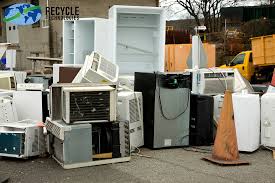Post Preview
Table of Contents
- Why Appliance Disposal Matters
- Common Types of Appliances Needing Removal
- Dangers of Improper Disposal
- Preparing Your Appliances for Removal
- Eco-Friendly Disposal Options
- Recycling Centers and Programs
- DIY vs. Professional Appliance Removal
- What Happens After Recycling?
Why Appliance Disposal Matters
The way society handles the removal and disposal of old appliances has rippling consequences for both local environments and the planet as a whole. Unsurprisingly, the U.S. Environmental Protection Agency (EPA) reports that millions of appliances are discarded every year in the United States alone, ranging from refrigerators and washing machines to microwaves and air conditioners. When these items end up in landfills instead of being responsibly recycled, they can leak chemicals, release greenhouse gases, and occupy significant landfill space that could be used for conventional waste. That’s why practicing safe appliance disposal helps prevent harmful leaks, reduces air and soil pollution, and conserves valuable resources that would otherwise be wasted.
Choosing the correct disposal pathway for appliances means more materials can be recovered and reintroduced into manufacturing processes, such as metals, plastics, and even glass. These recovered items are given new life, supporting the circular economy rather than contributing to growing trash piles. Importantly, when appliances containing Freon or other refrigerants are handled correctly, the risk of ozone depletion is significantly reduced. This attention to proper disposal extends beyond simple household cleanliness to protect air and water for entire communities—now and for generations to come.
Common Types of Appliances Needing Removal
Almost every home, at one point or another, faces the challenge of needing to clear away aging, broken, or outdated large appliances. The main culprits are typically household fixtures like refrigerators, freezers, ovens, stoves, dishwashers, washing machines, dryers, microwaves, water heaters, and air conditioning units. These appliances can be cumbersome and may contain hazardous materials, making their removal and recycling a more complex task than simply disposing of them at the curb.
With technology rapidly evolving and a rising focus on energy efficiency, homeowners tend to replace appliances more frequently. According to insights from Wirecutter, today’s appliances are designed for affordability and energy savings but often have a shorter lifespan than older models. This shift in design and function results in an even greater volume of used appliances in need of responsible removal and recycling, making informed decision-making about their proper disposal increasingly important for families and communities alike.
Dangers of Improper Disposal
Thoughtlessly dumping an appliance—for instance, leaving it on the sidewalk, in an alley, or tossing it directly into a landfill—can result in a host of problems nobody wants to inherit. Many appliances, particularly refrigerators and air conditioning systems, are manufactured with chemical refrigerants such as CFCs or HCFCs. These chemicals, if not properly removed and disposed of, have been shown to deplete the ozone layer and contribute to global warming. Appliances also often contain hazardous substances, such as mercury in switches, PCB capacitors in older units, and heavy metals in electrical components, which can leach into groundwater as the appliance sits in a landfill.
Beyond environmental consequences, improper disposal can affect public health and safety. For example, a discarded refrigerator with the door still attached poses a potential hazard to children or wildlife. Communities have responded by creating strict regulations, sometimes with hefty penalties for non-compliance, to ensure these items are treated with the caution they deserve. For most households, staying informed about the risks and legal requirements associated with appliance disposal is crucial, not only to avoid fines but also to contribute to a solution that safeguards the neighborhood environment.
Preparing Your Appliances for Removal
Before you move that heavy fridge or well-used washer to its next destination, a little preparation dramatically improves safety and efficiency. To begin, always unplug and disconnect any gas or water lines. Fridges and freezers should be defrosted at least 24 hours in advance to prevent leaks and control odors. Washing machines and dishwashers, meanwhile, need to be completely drained—check hoses and remove all traces of water.
- Unplug and disconnect: Always ensure all power sources are safely turned off and appliances are fully unplugged or disconnected at the wall or power source.
- Drain and defrost: For appliances such as refrigerators and washers, drain water and defrost as necessary to prevent spills and minimize the movement of weight.
- Secure doors and loose parts: To prevent accidents, either remove appliance doors or secure them shut with tape. Remove any trays, shelves, or bins inside the unit and pack them separately if possible.
- Clean surfaces: Wipe out interior surfaces to reduce odors and make the appliance easier (and more pleasant) to handle for anyone involved in its removal or recycling.
Following these straightforward steps makes the removal process smoother and helps ensure safety, especially for professional haulers or recycling center staff who will handle your appliance next.
Eco-Friendly Disposal Options
Responsible recycling of old appliances is more accessible than ever, thanks to a wide range of green options available in many communities. Many municipalities provide curbside or bulk pickup services several times a year, often with advance scheduling. Retailers selling new appliances frequently offer to haul away the old unit for free or for a modest fee, ensuring it is sent directly to certified recycling partners.
- Municipal recycling programs: These local government initiatives may offer appliance pickup and designated drop-off sites for residents.
- Retailer take-back: Some major retailers coordinate the removal and eco-friendly disposal or recycling of your old appliance when you purchase a replacement, which significantly reduces the hassle of the process.
- Donation: Appliances that still work can be transformative for families in need or nonprofit groups, extending the item’s useful life and reducing waste.
- Scrap metal centers: Specialized recycling facilities dismantle appliances, capturing valuable metals and materials that can be reused across different industries—from auto parts to new household goods.
Even a brief check with your local public works department or utility provider can reveal helpful programs designed to make green disposal easy. These options keep precious resources in circulation and significantly reduce the strain on overburdened landfills.
Recycling Centers and Programs
Municipal recycling centers or specialized facilities are the backbone of eco-friendly appliance disposal. These operators possess the necessary tools, vehicles, and expertise to dismantle complex machines in a manner that safeguards both workers and the environment. Appliances are sorted by type, and hazardous materials—such as refrigerants, oils, and lead-containing parts—are removed with high standards of care.
To make the process seamless, it’s wise to call ahead before dropping your appliance off. Ask whether appointments are needed, what types of items are accepted, if proof of residence is required, and what preparation steps you should follow. Policies on fees and accepted materials can vary, so getting the details in advance is key. These centers are essential for ensuring that as much material as possible is reclaimed and reused and that hazardous components are safely disposed of, rather than posing risks to people or the environment.
DIY vs. Professional Appliance Removal
Deciding whether to remove appliances yourself or hire professionals involves considering safety, convenience, cost, and the peace of mind that comes with it. Although that comes with it, tough DIY might seem cheaper, but the heavy and awkward nature of large appliances can lead to injuries and regulatory issues. Professionals are trained to remove items safely, handle legal disposal, and provide quotes from suppliers, making the process easier and potentially more economical when hidden costs are considered. What Happens After Recycling?
Appliance recycling extends beyond disposal; it involves the careful removal of hazardous substances and the systematic dismantling of components for material recovery. Valuable metals and plastics are reused in new products, reducing the need for raw resource extraction and helping to preserve the environment. By choosing responsible recycling options, households contribute to improved air and water quality, support sustainable manufacturing, and foster a global movement for a cleaner planet.



